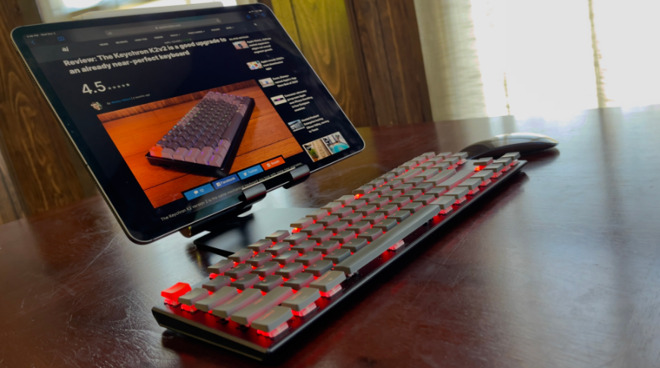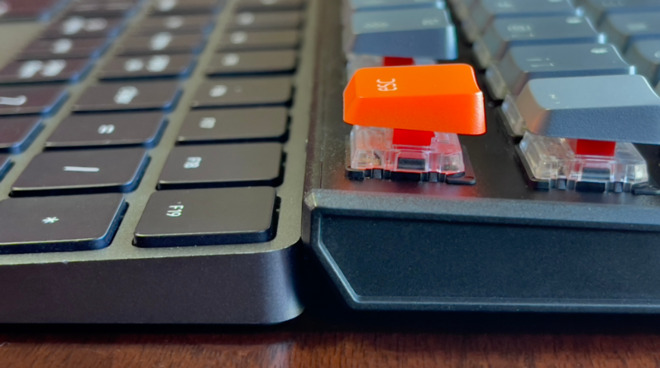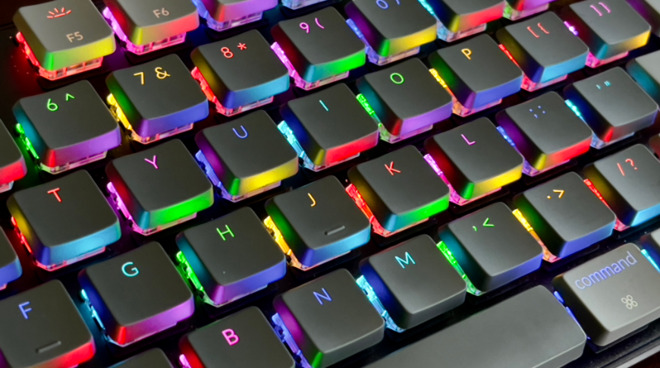Keychron K1 review: the wireless keyboard Apple should have made
Users familiar with the Apple Magic Keyboard will fall in love with the Keychron K1 with its slim design and comfortable typing experience.

The Keychron K1v4 is a slim mechanical keyboard with a great design
Keychron is a popular mechanical keyboard manufacturer with multiple design types and customization options. The most popular model is the larger Keychron K2 which AppleInsider reviewed at 4.5 stars.
The Keychron K1 is available in 87-key or 104-key configurations with white or RGB backlight options. Users upgrading their keyboard from the chiclet-style keys found in the Apple Magic Keyboard will find this a satisfying half-step to full-sized mechanical keyboards.
Version 4 is an iterative yet welcome update to the K1 version 3. The new features this time around include Bluetooth 5.1, curved keycaps with a new color scheme, and a caps lock indicator for 87-key keyboards.

The Keychron body (right) is not much bigger than the thin Apple Magic Keyboard (left)
The keys have minimal travel and feel similar to the chiclet keys found in Apple keyboards. The sound isn't too loud and the key feel is slightly mushy, but it's not a detriment to the typing experience.
Though it is low-profile, the mechanical keyboard still has the proper feel and feedback expected of its class. The keys are half-height and curved slightly to feel better on the finger as you touch-type.
The key caps seem to float above the keyboard case with a transparent portion letting the light shine through underneath. The lighting feels consistent and the different patterns work great during use.
Notably, the K1 does not have any kickstands to adjust the height. There are four small rubber feet for grip, but you're fundamentally stuck with the incline.
The Bluetooth 5.1 standard should equate to a stronger connection while using less power than previous generations. It also means switching between paired devices faster, which is performed by holding down the function key and pressing 1, 2, or 3 to select a device mapped to that key.
The backlight can be standard white or RGB. The RGB version can cycle between 18 types of backlight patterns using the lightbulb key in the top right of the keyboard.

There are a multitude of pattern and color combinations for the Keychron K1
Once the desired pattern is selected, users can further customize the experience by changing the dominant color of that pattern. This is done by holding the function key then pressing the left or right arrow key to switch colors.
Keychron implemented the same 12-key function row layout as Macs, so you'll effectively have all the same buttons on your Mac Keyboard.
Like all Keychron keyboards, the K1 is designed to be universally compatible across Mac, Windows, Android, and iPadOS. Using the switches in the back, users can move between the desired operating system, and cable or Bluetooth modes.
The Keychron K1v4 87-key option now has a caps lock indicator by the escape key. Previously it was impossible to tell the status of the caps key due to the color patterns of the keyboard, but the indicator eliminates that issue.
The keys are taller than the Magic Keyboard due to being a mechanical keyboard, but users won't have any trouble with touch typing.
The keys don't rock or feel cheap, and the spacebar depresses equally no matter where pressed. The design is striking, especially when the RGB effects are active.
The Keychron K1 is a stepping stone to larger mechanical keyboards like the K2
This mechanical keyboard is not for everyone. It fills a specific niche, where other keyboards like the Keychron K2 are more universal. The thin design and low-travel might turn some users away from the otherwise great keyboard.
The Keychron K1 is the perfect introductory mechanical keyboard for users coming from Apple's Magic Keyboard. It offers customization and the look and feel of mechanical keyboards without being too bulky or complex.
The price is easily the best feature, as users looking for Apple's wireless keyboard will need to spend at least $30 more for an arguably worse experience.
Pros

The Keychron K1v4 is a slim mechanical keyboard with a great design
Keychron is a popular mechanical keyboard manufacturer with multiple design types and customization options. The most popular model is the larger Keychron K2 which AppleInsider reviewed at 4.5 stars.
The Keychron K1 is available in 87-key or 104-key configurations with white or RGB backlight options. Users upgrading their keyboard from the chiclet-style keys found in the Apple Magic Keyboard will find this a satisfying half-step to full-sized mechanical keyboards.
Version 4 is an iterative yet welcome update to the K1 version 3. The new features this time around include Bluetooth 5.1, curved keycaps with a new color scheme, and a caps lock indicator for 87-key keyboards.
Design
Measuring 18mm thick, the thin aluminum body has is a slight incline in the base, unlike previous generations, meaning the keys will feel closer to your fingers as you reach.
The Keychron body (right) is not much bigger than the thin Apple Magic Keyboard (left)
The keys have minimal travel and feel similar to the chiclet keys found in Apple keyboards. The sound isn't too loud and the key feel is slightly mushy, but it's not a detriment to the typing experience.
Though it is low-profile, the mechanical keyboard still has the proper feel and feedback expected of its class. The keys are half-height and curved slightly to feel better on the finger as you touch-type.
The key caps seem to float above the keyboard case with a transparent portion letting the light shine through underneath. The lighting feels consistent and the different patterns work great during use.
Notably, the K1 does not have any kickstands to adjust the height. There are four small rubber feet for grip, but you're fundamentally stuck with the incline.
Technology
The Keychron K1v4 uses Bluetooth 5.1 and can connect to three devices at once. Users can also connect their iPad or Mac via the USB-C port to avoid delays or disconnects that occasionally happen with Bluetooth.The Bluetooth 5.1 standard should equate to a stronger connection while using less power than previous generations. It also means switching between paired devices faster, which is performed by holding down the function key and pressing 1, 2, or 3 to select a device mapped to that key.
The backlight can be standard white or RGB. The RGB version can cycle between 18 types of backlight patterns using the lightbulb key in the top right of the keyboard.

There are a multitude of pattern and color combinations for the Keychron K1
Once the desired pattern is selected, users can further customize the experience by changing the dominant color of that pattern. This is done by holding the function key then pressing the left or right arrow key to switch colors.
Keychron implemented the same 12-key function row layout as Macs, so you'll effectively have all the same buttons on your Mac Keyboard.
Like all Keychron keyboards, the K1 is designed to be universally compatible across Mac, Windows, Android, and iPadOS. Using the switches in the back, users can move between the desired operating system, and cable or Bluetooth modes.
The Keychron K1v4 87-key option now has a caps lock indicator by the escape key. Previously it was impossible to tell the status of the caps key due to the color patterns of the keyboard, but the indicator eliminates that issue.
Using the Keychron K1
The Keychron K1 is noticeably thin while in use. Compared to the Keychron K2, its base is much thinner, which makes use without a wrist rest much easier. Users coming from the Apple Magic Keyboard won't need to make any adjustments to their typing style due to key placement and style.The keys are taller than the Magic Keyboard due to being a mechanical keyboard, but users won't have any trouble with touch typing.
The keys don't rock or feel cheap, and the spacebar depresses equally no matter where pressed. The design is striking, especially when the RGB effects are active.
Should you buy the Keychron K1v4?

The Keychron K1 is a stepping stone to larger mechanical keyboards like the K2
This mechanical keyboard is not for everyone. It fills a specific niche, where other keyboards like the Keychron K2 are more universal. The thin design and low-travel might turn some users away from the otherwise great keyboard.
The Keychron K1 is the perfect introductory mechanical keyboard for users coming from Apple's Magic Keyboard. It offers customization and the look and feel of mechanical keyboards without being too bulky or complex.
The price is easily the best feature, as users looking for Apple's wireless keyboard will need to spend at least $30 more for an arguably worse experience.
Pros
- Thin and light design
- Decent travel and key response
- Bluetooth 5.1 makes switching faster and more reliable
- Consistent backlighting
- Quieter sound for same switch type
- "mushy" key feel

Comments
Of less portable models, after trying many keyboards (including the Keychron K2), my preference is for keyboards with TOPRE keys like Realforce and Fujitsu Happy Hacking KBs. My current preference is the HHKB Hybrid Type S.
I just wish Fujitsu would make a ten-keyless TOPRE KB that was more Mac friendly, with dedicated function keys, say, like the M1 MacBook Air’s keyboard.
Yay for BT 5.1, yay for being Mac-orientated, and yay for "slim" and "light" design (compared to other mechanical keyboards, I guess, since it is photographically obvious that it is nowhere near as slim as the Magic Keyboard). I do get that some people want a real mechanical keyboard, and this one sounds very well made -- it might well appeal since it isn't as huge/heavy/gaudy as most of the ones aimed at PC gamer teens, but I think this one tries to go halfway been the type of keyboard most adults use and the gamer market disco keyboards, at a very reasonable price -- but the flaw here isn't the keyboard as much as it is the approach of the review.
It's a very odd and negative flex to attack another specific keyboard throughout the piece in order to try and promote this keyboard's "strengths" when it is pretty obvious that this keyboard is in no way trying to "compete" with the Magic Keyboard or indeed any other type of non-mechanical "standard" notebook/external keyboard. Even without trying the keyboard, I can assure you that I am absolutely not going to "fall in love" with the K1 anymore than I would "fall in love" with one of those Kickstarter "steampunk" typewriter-type BT or USB keyboards. I'm also not "in love" with any of the four keyboards I routinely use.
However, this keyboard is now in its fourth iteration and has undergone some rather drastic changes in terms of appearance and feel. If you bought this keyboard nine months ago and bought the current shipping model, you might end up with two very different ideas about how good they are.
I have a Keychron K1 version 2, which means flat keycaps and no adjustable feet. The former makes it feel more like an old Apple keyboard (my K1 replaced an old wired Apple Keyboard with the chiclet keys, model A1242, circa 2008).
I bought the white LED backlight version so any disdain about the garishness of the disco-like RGB backlighting is irrelevant. Keychron apparently also improved Bluetooth performance compared to the original v1 model and they ditched some of the old keys (voice dictation is one) that some of the early reviewers covered.
With K1 v2, Keychron also added several switch options. I opted for the quiet Gateron reds (they also offered brown and blue); early reviews of the Keychron K1 v1 mention that the keyboard was limited to noisy/clicky blue switches. The v2 version also has black keycaps for a very harmonious look. With the v3 and later versions, Keychron moved to a two-toned sculpted keycap color pattern which I find rather ugly. Unfortunately, they have not offered the old black flat keycaps as a built-to-order option for the v3 or v4 nor have they offered the flat black keycaps as an add on replacement set.
It did not take me long to get used to the K1 v2.
More recently, I picked up a Keychron K8 for use with another computer (a Windows PC). It has the ugly two-tone keycaps but with sculpted tops. This is the best feeling computer keyboard that I have used since a mid-Nineties SGI keyboard. Again, I picked the Gateron red switches for my Keychron K8 with the plain white LED backlight. With Apple's own keyboards, there is no choice of switch type.
At some point I might replace the K8 keycaps with some other set of Cherry MX-compatible keycaps but I'm in no rush. At least the K8 is compatibile with those standard keycaps.
The K1's low-profile keycaps don't really allow for many customization options.
Like all input peripherals (mice, trackpads, gamepads, digitizing tablets, etc.), keyboards are highly personal devices and what is ideal for one person may be someone else's nightmare.
For sure no one can please everyone all the time and it's unclear if the review author actually understands this given the heavy use of superlatives (maybe they're hyperboles, hard to tell). One thing, some of the commenters here don't seem to recognize this.
In any case, I have given Keychron my money for a couple of keyboards and didn't send them back for a refund.
The review author did get one fact correct: the Keychrons are cheaper than the Apple equivalents.
The Keychrons are also compatible with Windows/Android devices and include replacement keycaps (Siri/Cortana, alt/command, Windows/option) as well as a convenient keycap pulling tool. There's also a physical switch to go between Mac and Windows/Android mode.
In summary, the various Keychron keyboard models should be a consideration for anyone looking for an alternative to Apple's own offerings. For sure, the Keychron keyboard aesthetics don't have the same harmony as the Apple keyboards but I'm using my K1 with a Mac mini parked out of sight driving a 32" Dell monitor. My Apple keyboard model A1242 remains mothballed in a closet if I ever want the Apple typing experience.
But seriously: I'm happy that AI reviews third party versions of hardware that's also made by Apple. There are companies offering products with great design and innovation at cheaper-than-Apple price points. Truth is, I actually find Keychron's mechanical keys kind of intriguing, and if I saw one at Best Buy, I'd definitely want to give it a try. But even if I loved the feel of typing with it, I would not put anything this butt ugly on my desk. Safe to say, Keychron will not be winning a Red Dot Design award anytime soon. If they're going to go through the trouble of creating a new, lower profile model of a mechanical keyboard, then why not spend some extra money and hire a good industrial designer to give it a great look? I get that a mechanical keyboard is never going to have the sleek flatness of a Magic Keyboard, and I'm fine with that... but there's no need for it to look as awful as it does.
This was my first thought. Well actually my first thought was "this keyboard is uglier than the devil's bung-hole". This was quickly followed by, "this is the keyboard Apple should have made if they wanted to ensure that Johnny Ive starts spinning in grave now before he even dies for having ever worked at a place that could produce something so garish".
Maybe something like this was pitched in some meeting that Johnny was part of and that is the real reason that he left Apple.
Let me ask this, "would AI have given this product a full five stars if some part of this keyboard was made of Horween leather"? Would all-leather keycaps that develop a beautiful "unique patina" over time to individualize your typing experience be enough to push this to five stars or would it still need a bottom pad made of soft merino wool to really get there?
Only if Apple’s design house started using really low-grade crack.